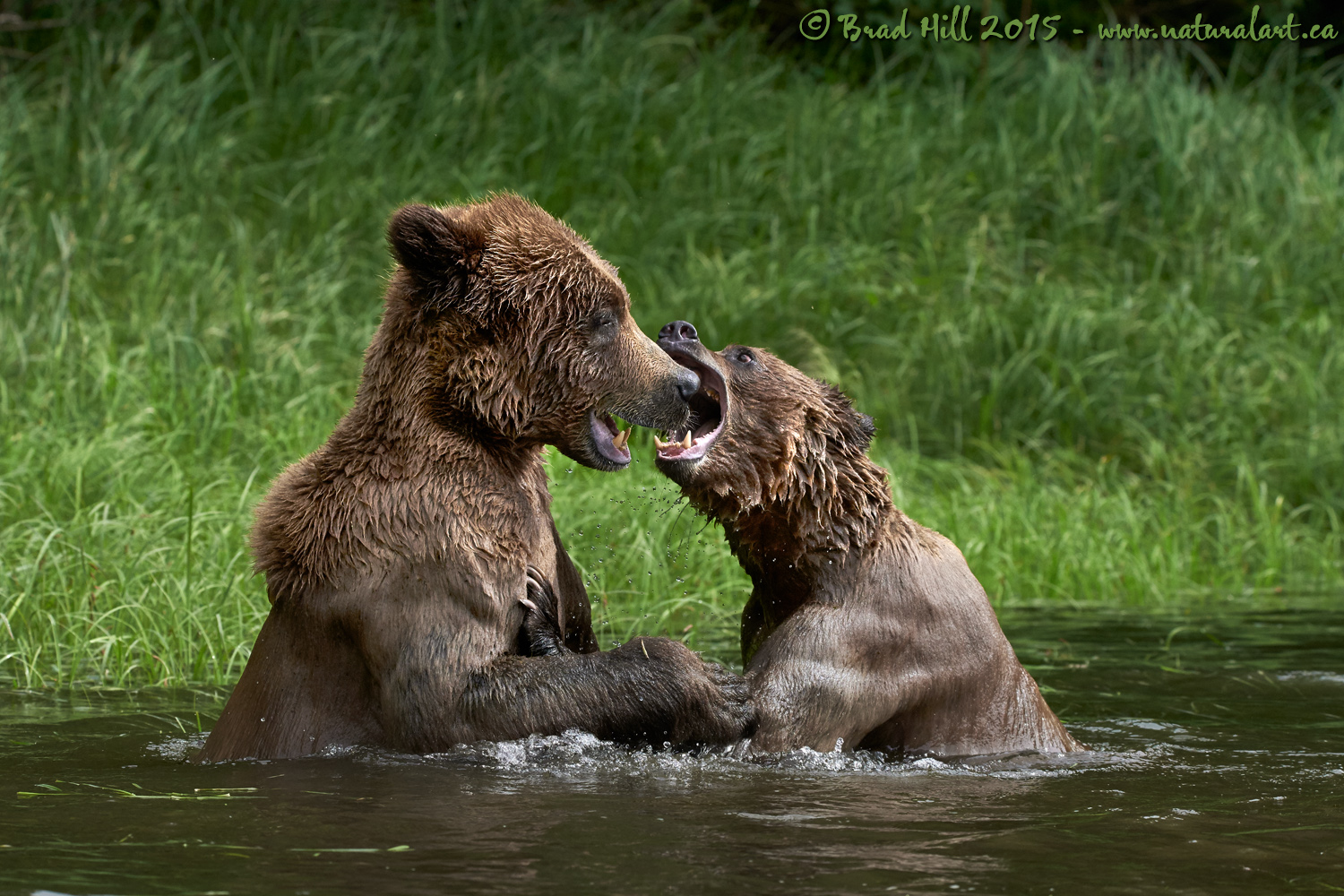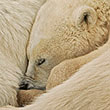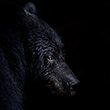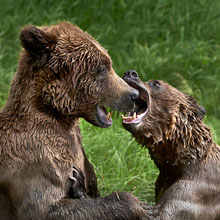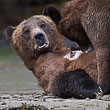Availability: Undetermined - Enquiries?
In the Field
Putting the Bite On! Khutzeymateen Grizzly Sanctuary, northern BC coast, Canada, BC, Canada. June 2, 2015.
I really wanted the title of this image to be "Putting the Bite On the Competition", but between the title length and a possible debate over whether these two siblings are actually competing for any resources I thought it better to go the shorter route...
The encounter where I captured this image was one of those "Man...I'll remember that forever" situations. From beginning to end this sparring event (and a few chases that occurred mid-way through!) lasted under 5 minutes, but WHAT ACTION! These two grizzlies are siblings - the smaller bear on the right is a female and the one on the left is a male. They're 5 years old and split apart after being weaned in their 4th spring. It seems whenever they re-unite they revert back to being playful littermates without missing even a beat. Seconds before I shot this image the male had completely dunked the female's head (and he seemed to hold her under a little longer than needed) and here she's roaring back with vengeance. What a cool thing to see and photograph.
Two technical (geeky?) comments associated with this image. When I captured this shot in late spring of 2015 I was in the midst of evaluating the Sigma Sport 150-600mm. By the time I shot this scene with the lens I already had a lot of confidence in it, but this five minute sequence convinced me the lens was a real keeper. Not only is the overall optical quality of the lens excellent, but this sequence showed me the value of the lens's wide focal range. This shot was captured at 185mm on a D750 (and it's virtually full frame) and I captured a range of shots from this focal range all the way up to 550mm. I love good prime lenses, but in this ephemeral encounter you didn't want to be wasting time switching between primes (the bears were moving around somewhat and our Zodiac was drifting around, so you constantly needed to be shifting focal lengths...plus, of course, I wanted a nice mix of tighter and "wider" shots).
Second...it's sometimes easy to forget how fast our cameras have been improving (and making our life easier and our images better) over the past few years. This image was shot at "only" ISO 2200 - with that ISO I could stop down enough (to get the DoF the way I wanted it) and still use a fast enough shutter speed to freeze the action (here I used 1/1600s). A few short years ago (prior to the introduction of the D3) I would have been limited to about 400 ISO, which would have introduced more compromises I would have been forced to make (to begin with, I would have to have "given" up some DoF OR shutter speed, or both). As a wildlife photographer who shoots in low light a lot excellent ISO performance is just SO critical to what I do. Obviously a good AF system is important too, but in my case the limiting factor is more often ISO than it is focusing. Which means my number ONE concern in a wildlife camera is ISO performance...with frame rate, buffer size, AF performance, and kit durability all fighting for second spot on my list of priorities.
Here's a higher resolution (2400 pixel) version of the shot for those wanting to see more detail:
• Putting the Bite On! Download 2400 pixel image (JPEG: 1.7 MB)
ADDITIONAL NOTES:
1. This image - in all resolutions - is protected by copyright. I'm fine with personal uses of them (including use as desktop backgrounds or screensavers on your own computer), but unauthorized commercial use of the image is prohibited by law. Thanks in advance for respecting my copyright!
2. This image was captured during one of my two spring "Grizzlies of the Khutzeymateen" photo tours in May/June of 2015. Each year I offer trips into two different parts of the Great Bear Rainforest as well as one to photograph aquatic mammals and oceanscapes near the northern tip of Vancouver Island. And, in selected years, I also offer photo tours to locations to capture other highly sought-after subjects, such as various boreal owl species and wildlife of Canada's Arctic. Details about these trips can be found on the Photo Tours page of this website.
3. Like all wildlife photographs on this website, this image was captured following the strict ethical guidelines described in The Wildlife FIRST! Principles of Photographer Conduct. I encourage all wildlife photographers to always put the welfare of their subjects above the value of their photographs.
Behind the Camera
Putting the Bite On! Khutzeymateen Grizzly Sanctuary, northern BC coast, Canada, BC, Canada. June 2, 2015.
Digital Capture; Compressed RAW (NEF) 14-bit format; ISO 2200.
Nikon D750 paired with Sigma Sport 150-600mm zoom @ 185mm. Hand-held from floating Zodiac. Optical stabilization on and in "OS1" mode.
1/1600s @ f8; -0.33 stop compensation from "recommended" matrix-metered exposure setting.
At the Computer
Putting the Bite On! Khutzeymateen Grizzly Sanctuary, northern BC coast, Canada, BC, Canada. June 2, 2015.
RAW Conversion to 16-bit TIFF using Phase One's Capture One Pro 8. Four raw variants (different versions of a single raw capture) processed, with the variants differing in exposure (0.6 stop total difference between the variants) and shadow recovery settings.
Further digital corrections on resulting 16-bit TIFF files using Adobe's Photoshop CC 2015 and Light Crafts Lightzone. Photoshop adjustments included compositing (blending) of the four output files from the raw converter, minor exposure tweaks, final selective sharpening for web output. Final tone-tweaking performed using LightZone's "tonemapper" tool.
Conservation
Putting the Bite On! Khutzeymateen Grizzly Sanctuary, northern BC coast, Canada, BC, Canada. June 2, 2015.
Ten percent of the revenue generated by this image will be donated to Raincoast*.
Species Status in Canada**: Special Concern (May 2002).
While Grizzly Bears (Ursus arctos) are not technically listed as "Endangered" in Canada, they have been extirpated from most of their historical range. Grizzly Bears are far more sensitive to intrusion/disturbance in their habitat than are Black Bears and are being increasingly forced into marginal habitat by human encroachment. The Great Bear Rainforest along the central and northern coast of British Columbia is one of the last strongholds of the Grizzly Bear in Canada, and even this population is coming under increasing pressure.
On December 18, 2017 the government of British Columbia banned grizzly hunting across the entire province. This major conservation victory came after decades of tireless work by many dedicated conservationists and ecologists and, most importantly, it reflects the opinion of the vast majority of British Columbians. And, it means that AT LEAST while the current government remains in power grizzlies are finally "safe" in British Columbia.
Now that we've at least temporarily won the battle to save grizzlies in BC, it's time to re-focus our efforts toward protecting ALL of BC's carnivores, including Gray Wolves, Black Bears, Cougars, Wolverines, and more! Simply put, there are no ecological, economic, or ethical arguments supporting the trophy hunting of carnivores.
In a great first step towards ending the hunting of carnivores throughout BC the Raincoast Conservation Foundation has developed a program designed to protect ALL carnivores within the Great Bear Rainforest. Details about this program can be found on this page on Raincoast's website. Check it out and, better yet, make a donation to help Raincoast purchase the remaining commercial hunting tenures in the Great Bear!
*The Raincoast Conservation Society (and Foundation) is an effective and efficient organization that has been fighting for protection of this unique habitat. If you are looking for a meaningful way to contribute to the conservation of this amazing ecosystem, Raincoast will provide maximal "bang" for your conservation dollars.
**as determined by COSEWIC: The Committee on the Status of Endangered Wildlife in Canada












